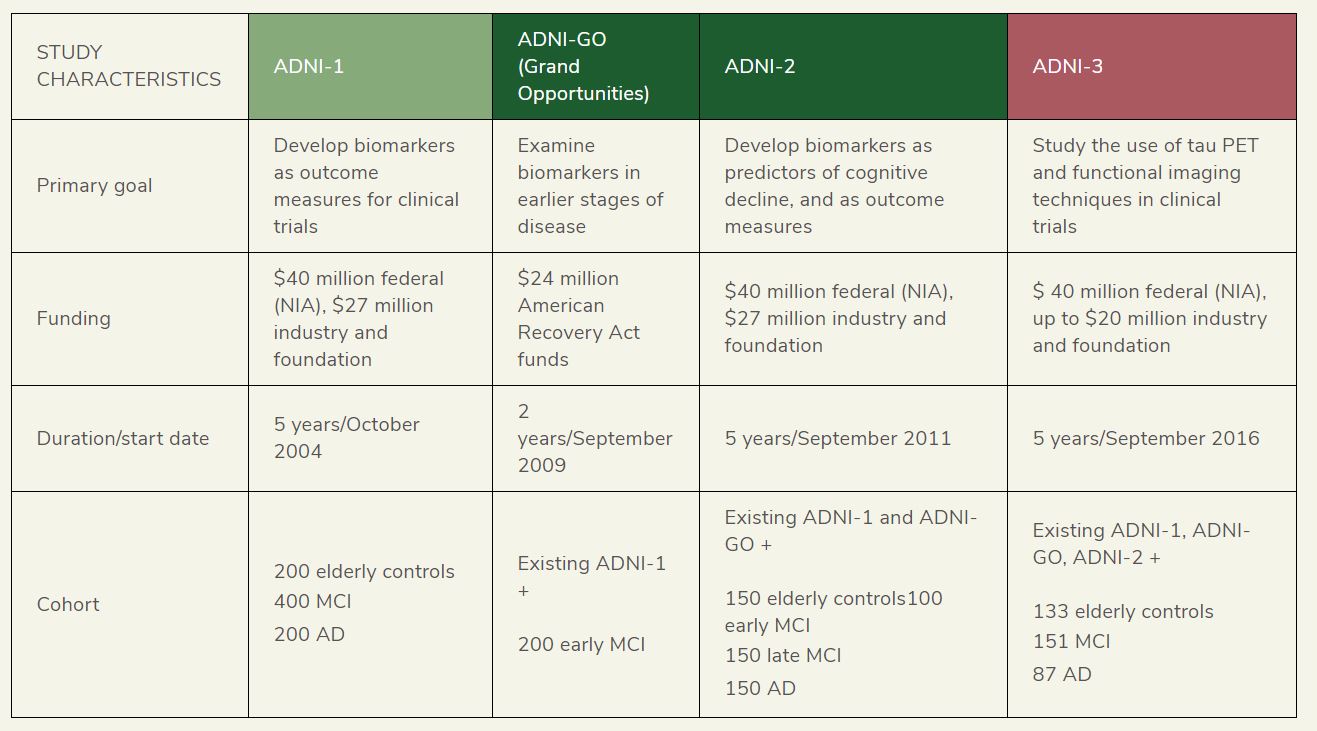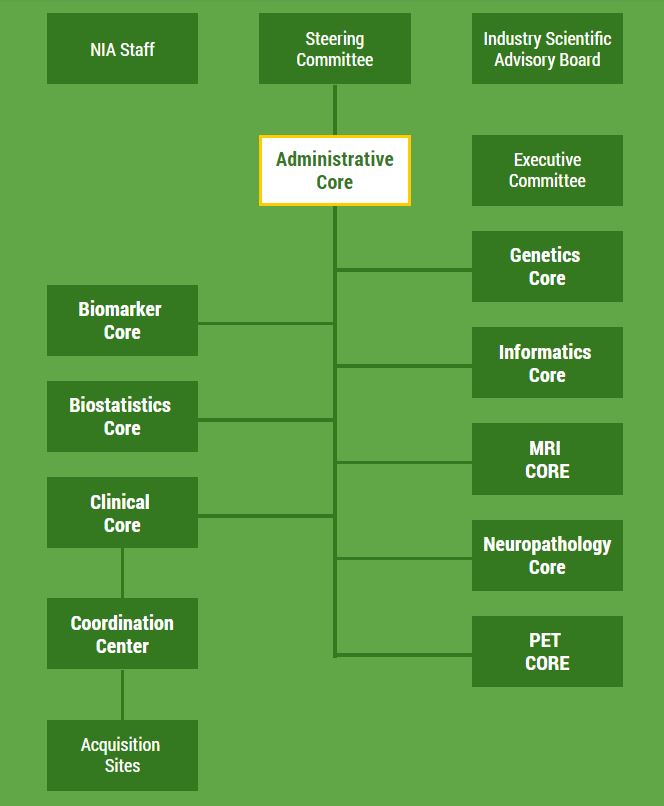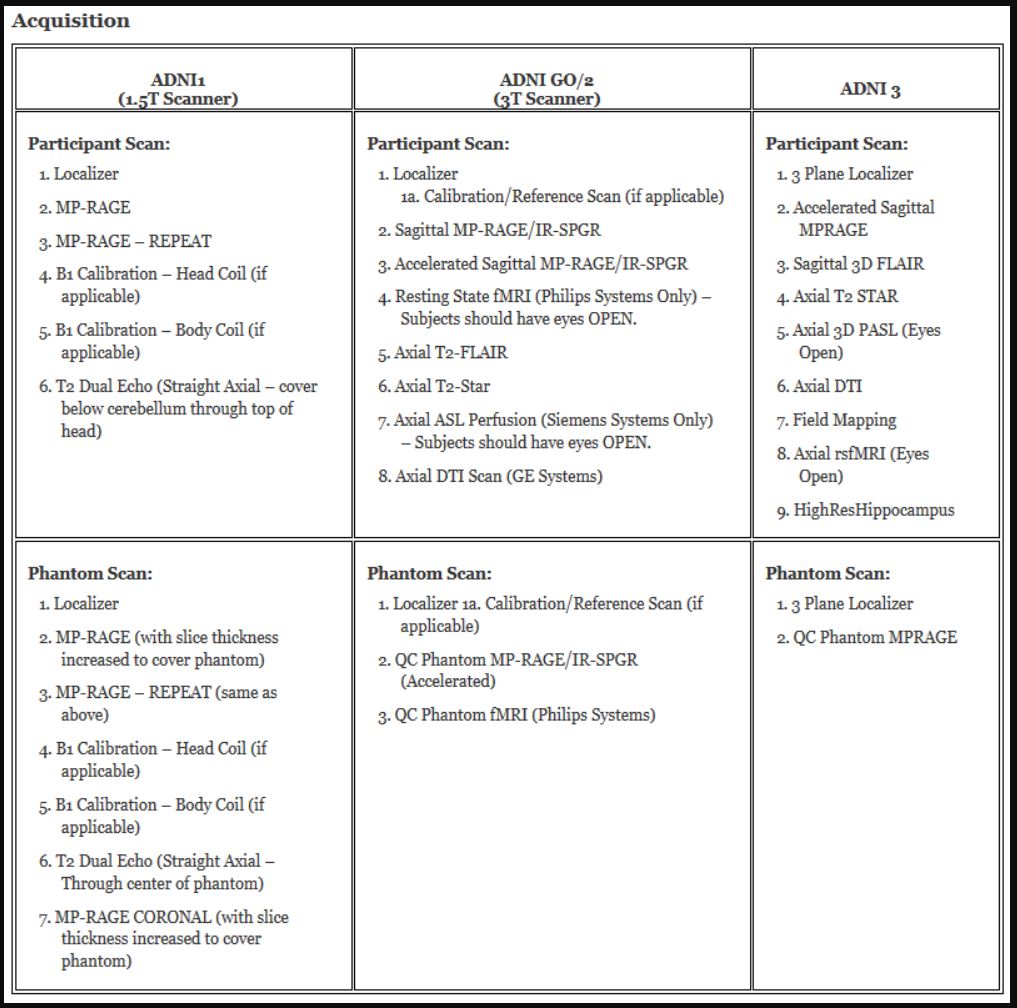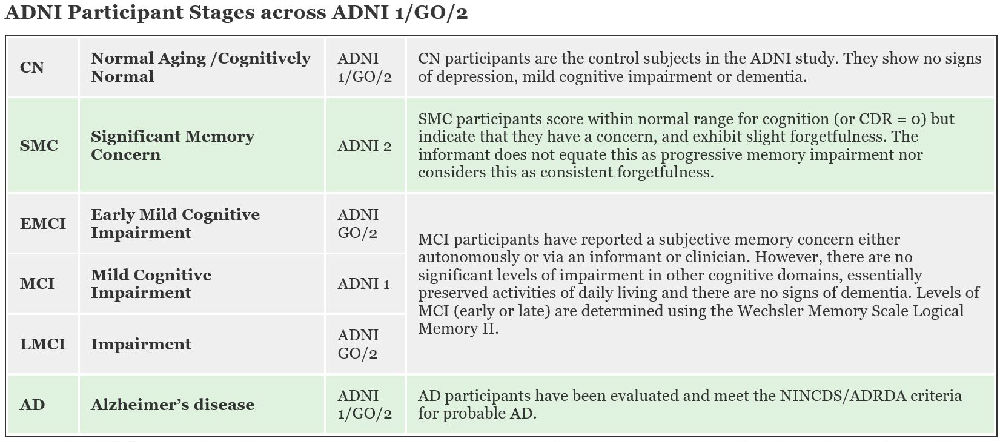博文
ADNI Introduction
||
0. ADNI includes MRI and PET images, genetics, cognitive tests, CSF and blood biomarkers as predictors of the disease. This dataset is managed by the stuffs in the U. of Southern California. Participants are from the North American, including Canada and USA.
The site builds upon the ADNI1, ADNI-GO, and ADNI2 studies, public-private collaborations aimed at determining the relationships between clinical, cognitive, imaging, genetic and biochemical biomarkers across the entire spectrum of AD. ADNI3 will continue efforts to discover, optimize, standardize, and validate clinical trial measures and biomarkers used in AD clinical research.


![]()
(Figures are from http://adni.loni.usc.edu/about/)
1. AD basic knowledge: This multisite, longitudinal study assesses clinical, imaging, genetic and biospecimen biomarkers through the process of normal aging to early mild cognitive impairment (EMCI), to late mild cognitive impairment (LMCI), to dementia or AD
The individuals with EMCI still have a diagnosis of MCI, but have less memory impairment than the MCI subjects recruited during ADNI1 (Late MCI or lMCI).
You can identify the eMCI subjects by merging the ARM table with the Diagnostic Summary table and identifying those with ARM==10 & DXCHANGE==2
2. MRI

(This figure is from http://adni.loni.usc.edu/wp-content/themes/freshnews-dev-v2/documents/mri/Acquisition_Table.png)
ADNI1:
I. only sMRI;
II. scanns were scanned using either 1.5T or 3.0T scanner
ADNI2/GO:
I. sMRI, fMRI, and DTI. DTI scans are available only from ADNI 2/GO subjects who were scanned with a GE Systems MR Scanner.
II. All participants newly enrolled in ADNI2 are scanned using the 3T MRI scanning protocol.
III. ADNI2 participants are scanned at screening, 3 months from the screening MRI, and within two weeks before or after Month 6 and subsequent annual visits.
ADNI3:
Note: When searching the database for baseline or “Timepoint 1″ data, users should select both “screening” and “baseline” from the visit selection box.
From: http://adni.loni.usc.edu/data-samples/mri/

Normal (CN)4 and Mild Cognitive Impairment (MCI)4 participants carried forward from ADNI1 and Early Mild Cognitive Impairment (EMCI)5 participants from ADNI GO are also scanned using the more modern and expanded 3T scanning protocol.
3. Study design for the ADNI trial
AD subjects (200) will be studied at 0, 6, 12, 24 months.
MCI subjects at high risk for conversion to AD (400) will be studied at 0, 6, 12, 18, 24, 36 months.
Age matched controls (200) will be studied at 0, 6, 12, 24 and 36 months.
25% of the subjects will be scanned at 3 Tesla at every timepoint.
1.5T Scans = 4200 -- 3T Scans = 1050 Total MRI scans performed for ADNI trial: 5250
4. Images on ADNI have no atlas
There are values for hippocampal valume, determined by the Freesurfer Method in the ADNI data set
5. DocumentSummary.csv文件中DXCHANGE的值及对应的状态:
1=Stable: NL to NL;
2=Stable: MCI to MCI;
3=Stable: Dementia to Dementia;
4=Conversion: NL to MCI;
5=Conversion: MCI to Dementia;
6=Conversion: NL to Dementia;
7=Reversion: MCI to NL;
8=Reversion: Dementia to MCI;
9=Reversion: Dementia to NL
6. The ranges (code values) of ARM in the table of ARM.csv
| Definition | Diagnosis/Scan Category Assignment |
| Code | 1=NL - 1.5T only;2=MCI - 1.5T only;3=AD - 1.5T only;4=NL - PET+1.5T;5=MCI - PET+1.5T;6=AD - PET+1.5T;7=NL - 3T+1.5T;8=MCI - 3T+1.5T;9=AD - 3T+1.5T |
| Phase | ADNI1 |
Table | ARM |
| Definition | Diagnosis/Scan Category Assignment |
| Code | 1=NL - 1.5T only;2=MCI - 1.5T only;3=AD - 1.5T only;4=NL - PET+1.5T;5=MCI - PET+1.5T;6=AD - PET+1.5T;7=NL - 3T+1.5T;8=MCI - 3T+1.5T;9=AD - 3T+1.5T;10=EMCI |
| Phase | ADNIGO |
Table | ARM |
| Definition | Diagnosis/Scan Category Assignment |
| Code | 1=NL - (ADNI1 1.5T only); 2=LMCI - (ADNI1 1.5T only); 3=AD - (ADNI1 1.5T only); 4=NL - (ADNI1 PET+1.5T); 5=LMCI - (ADNI1 PET+1.5T); 6=AD - (ADNI1 PET+1.5T); 7=NL - (ADNI1 3T+1.5T); 8=LMCI - (ADNI1 3T+1.5T); 9=AD - (ADNI1 3T+1.5T); 10=EMCI; 11=SMC - (Significant Memory Concern) |
| Phase | ADNI2 |
| Table | ARM |
7. Please use RID as the subject unique identifier
8.The screening visit consists of a subset of the planned assessments (neuropsychological testing, imaging, etc.) sufficient to evaluate the inclusion/exclusion criteria for each potential participant. Once a participant passed screening, the baseline assessment was conducted in which additional neuropsychological testing, imaging, and fluid samples were taken. The diagnosis at the screening diagnosis was used to randomize individuals to an arm of the ADNI-1 study (1.5T only, 1.5T + 3T, 1.5T + FDG-PET), but the diagnosis from the baseline visit is considered more accurate. For most individuals, the two diagnoses are the same, but the diagnosis did change for a handful of subjects.
9.Recommended Image Data: Which scan to select?
For researchers who are interested in the imaging process as a whole, imaging files are available at every stage of pre- and post-processing. However, most researchers will prefer to use the scans that have undergone the maximum level of correction. These MPRAGE files are considered the best in the quality ratings and have undergone gradwarping, intensity correction, and have been scaled for gradient drift using the phantom data. These files are identified with “N3″ and “scaled” in the file name.
10. Clinical Reads
1. Every subject for the ADNI must receive a clinical read by an on-site
radiologist at each MRI facility. The clinical read should follow standard local
practice and a clinical dictation of the read should be transferred to the study
coordinator at the referral site.
2. Clinical reads will not be provided by Mayo QC or LONI.
https://blog.sciencenet.cn/blog-1969089-1046865.html
上一篇:关于Stroke疾病的报告
下一篇:websites about brain atlas